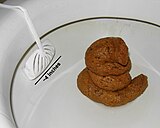**Characteristics of Feces:**
– Hydrogen sulfide and compounds like skatole, thiols, amines, and carboxylic acids contribute to the distinctive odor of feces.
– Skatole is produced from tryptophan via indoleacetic acid, and decarboxylation results in its production.
– The bad odor of feces may deter humans from consumption.
**Physiology of Defecation:**
– Feces are discharged through the anus or cloaca during defecation.
– Defecation requires pressures up to 100 millimeters of mercury in humans, generated by muscular contractions and gas buildup.
– Pressure prompts the sphincter to release the feces, with penguins requiring pressures of up to 450 millimeters of mercury for defecation.
**Ecological Importance of Feces:**
– Feces retain about 50% of the energy from the original food and are essential for decomposers in ecosystems.
– Various organisms feed on feces, and coprophagia occurs in animals like elephants, dogs, rabbits, and monkeys.
– Feces aid in seed dispersal for plants through frugivores.
**Human Feces:**
– Human defecation frequency varies, and fecal appearance changes based on diet and health.
– The color and texture of feces vary throughout a person’s life, with constipation being the extensive hardening of feces.
– Newborn feces contain only bile, giving it a yellow-green color.
**Uses of Animal Feces:**
– Animal feces like guano and manure are used as fertilizer, and dry animal dung is burned as fuel in many countries.
– Gut bacteria in animals like pandas and zebras can produce biofuel, and coprolites provide evidence of the diet of extinct organisms.
– Palaeofeces found in archaeological sites help determine ancient diets and health, with various unconventional uses of animal feces in different cultures.
Feces (or faeces; sg.: faex) are the solid or semi-solid remains of food that was not digested in the small intestine, and has been broken down by bacteria in the large intestine. Feces contain a relatively small amount of metabolic waste products such as bacterially altered bilirubin, and dead epithelial cells from the lining of the gut.
Feces are discharged through the anus or cloaca during defecation.
Feces can be used as fertilizer or soil conditioner in agriculture. They can also be burned as fuel or dried and used for construction. Some medicinal uses have been found. In the case of human feces, fecal transplants or fecal bacteriotherapy are in use. Urine and feces together are called excreta.



